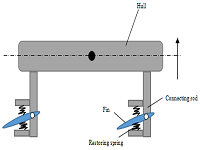Propulsion Performance Analysis of Wave-powered Boats
DOI:
https://doi.org/10.46604/ijeti.2020.4276Keywords:
wave-powered boat, dynamics analysis, ADAMSAbstract
With the development of oceanographic research and marine environment protection, mobile marine platforms are applied for ocean observation for a long journey. Wave-powered boats are capable of applying wave motion to propel itself and make a long-duration survey. This paper presents the dynamics of the wave-powered boat under the excitation of the heave motion and pitch motion. Taking the wave-powered boat with double fins as an example, the heave and pitch motions of the boat are obtained by ANSYS-AQWA firstly. Then the relationship between propulsion performance and three factors, including wave height, wave period, and restoring stiffness of torsion spring, was analyzed through multibody dynamics software ADAMS. With the increase of sea state from level 1 to level 4 the average propulsion speed increased from 0.4m/s to 1.4m/s. Under the same wave height and period, with the increase of restoring stiffness of torsion spring from 0.0125N·m/deg to 0.3N·m /deg, the propulsion speed of the wave-powered boat increases first and then decreases, and there exists an optimum stiffness. Through the calculation it is found that when the restoring stiffness of torsional spring is increased from 0.025N·m /deg to 0.2N·m /deg with the sea state level 1 to 4, the wave powered boat has better propulsion performance.
References
H. Linden, Improved combination with floating bodies, of fins adapted to affect their propulsion, U. S. Patent, 14630, 1895.
E. Jakobsen, The foil propeller, wave power for propulsion, U. S. Patent, 1981.
H. Isshiki, M. Murakami, and Y. Terao, “Utilization of wave energy into propulsion of ships-wave devouring propulsion,” 15th Symposium on Naval Hydrodynamics, Hamburg, September 1984, pp. 539-552.
Y. Terao and N. Sakagami, “Design and development of an autonomous wave-powered boat with a wave devouring propulsion system,” Advanced Robotics, vol. 29, no. 1, pp. 89-102, January 2015.
Y. Terao, “A floating structure which moves toward the waves : possibility of wave devouring propulsion,” Journal of the Kansai Society of Naval Architects Japan, vol. 57, pp. 51-54, 1982.
H. Isshiki, M. Murakami, and Y. Terao, “Thrust generation by a hydrofoil driven by waves: a basic aspect of wave devouring propulsion,” Hydrodynamics of Ocean Wave-Energy Utilization, pp. 227-236, 1986.
Y. Terao, “Wave devouring propulsion system: from concept to trans-pacific voyage,” ASME 2009 International Conference on Ocean, Offshore and Arctic Engineering, January 2009, pp. 119-126.
K. A. Belibassakis and G. K. Politis, “Hydrodynamic performance of flapping wings for augmenting ship propulsion in waves,” Ocean Engineering, vol. 72, no. 4, pp. 227-240, November 2013.
K. A. Belibassakis and E. S. Filippas, “Ship propulsion in waves by actively controlled flapping foils,” Applied Ocean Research, vol. 52, pp. 1-11, August 2015.
C. Li, D. J. Wang, J. W. Ye, D. Y. Li, and F. Liang, “Free running model tests and numerical simulation on a wave propelled craft,” Chinese Journal of Ship Research, vol. 9, no. 2, pp. 6-11, April 2014.
C. Li, “Experimental research on a wave propelled craft,” M.S. dissertation, South China University of Technology, Guangzhou, 2014.
Y. Y. Zheng, “The research on the hydrodynamic performance of wave energy propelled unmanned observation catamaran,” M. S. dissertation, South China University of Technology, Guangzhou, 2015.
M. X. Zhu, N. Ma, X. C. Gu, and S. J. University, “Study on wave motion and added resistance of a ship with hydrofoils assisting propulsion,” Ship Engineering, vol. 36, no. 2, pp. 20-24, 2014.
P. Y. Feng, N. Ma, and X. C. Gu, “Application of wave energy recovery by oscillating wings in Energy-efficient ship propulsion,” Journal of Shanghai Jiao Tong University, vol. 47, no. 6, pp. 923-927, June 2013.
Z. X. Feng, Z. Y. Chang, Z. Q. Zheng, and P. F. Wang, “Effects of connection type between surface vessel and submersible propeller on motion performance of wave glider,” Applied Sciences, vol. 8, no. 12, pp. 2467, December 2018.
X. X. Du, H. Cui, and Z. H. Xiang, “The multi-body system dynamics modeling of wave-driven underwater vehicle based on kane method,” Acta Armamentarii, vol. 37, no. 7, pp. 1236-1244, July 2016.
B. Q. Tian and L. L. Li, “Structure design and movement principle of wave gliders with webbed wings,” China Mechanical Engineering, vol. 28, no. 24, pp. 2939-2943, July 2017.
K. Suastika and Apriansyah, “Effects of stern-foil submerged elevation on the lift and drag of a hydrofoil craft,” IOP Conference Series Earth and Environmental Science, vol 135, no. 1, pp. 012003, March 2018.
J. A. Bowker, N. C. Townsend, and M. Tan, “Experimental study of a wave energy scavenging system onboard autonomous surface vessels,” Oceans, Genova, May 2015.
W. A. D. S. Liyanarachchi and H. Yamaguchi, “Numerical study on active wave devouring propulsion,” Journal of Marine Science and Technology, vol. 17, no. 3, pp. 261-275, September 2012.
F. C. Chiu, W. F. Li, and W. C. Tiao, “Preliminary study on a concept of wave propulsion by an active pitch-oscillating fin,” Oceans, Taipei, November 2014.
S. W. Huang, T. L. Wu, and Y. T. Hsu, “Effective energy-saving device of Eco-Ship by using wave propulsion,” Techno-Ocean, Japan, October 2016.

Published
How to Cite
Issue
Section
License
Copyright Notice
Submission of a manuscript implies: that the work described has not been published before that it is not under consideration for publication elsewhere; that if and when the manuscript is accepted for publication. Authors can retain copyright in their articles with no restrictions. Also, author can post the final, peer-reviewed manuscript version (postprint) to any repository or website.

Since Jan. 01, 2019, IJETI will publish new articles with Creative Commons Attribution Non-Commercial License, under Creative Commons Attribution Non-Commercial 4.0 International (CC BY-NC 4.0) License.
The Creative Commons Attribution Non-Commercial (CC-BY-NC) License permits use, distribution and reproduction in any medium, provided the original work is properly cited and is not used for commercial purposes.






.jpg)


